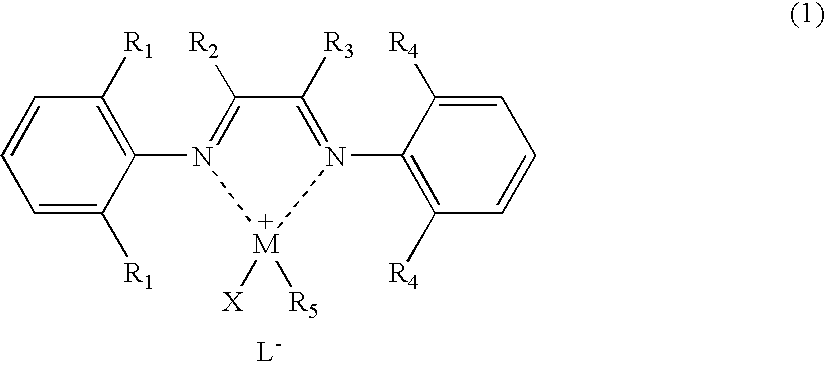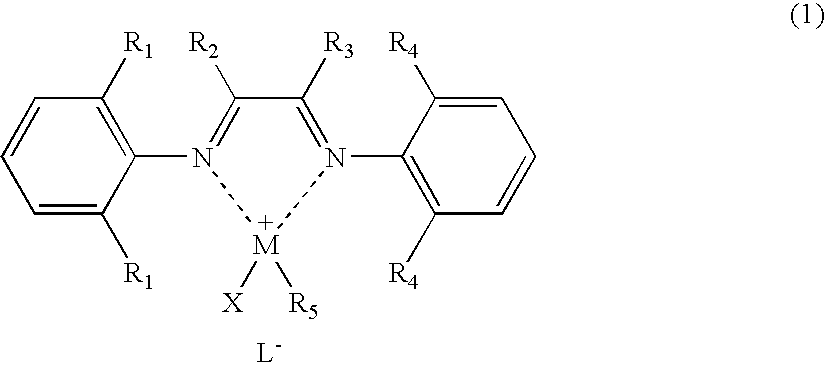Polyolefin graft copolymer obtained by using late transition metal complex coordination polymerization catalyst and method for producing same
a polymerization catalyst and polymerization technology, applied in the field of new polyolefin graft copolymer, can solve the problems of high temperature and high pressure, inability to meet the requirements of low polarity resins, and inability to substantially polymerize ethylen
- Summary
- Abstract
- Description
- Claims
- Application Information
AI Technical Summary
Problems solved by technology
Method used
Image
Examples
synthetic example 1
Synthetic Example of Silicone Macromonomer
[0065] In a reactor, 80 g of water, 30 g of octamethyltetracyclosiloxane (produced by Dow Corning Toray Co., Ltd.), 1.5 g of 3-acryloxypropylmethyldimethoxysilane (produced by Shin-Etsu Chemical Co., Ltd.), and 0.6 g of a 25% aqueous solution of sodium dodecylbenzenesulfonate (Neopelex produced by Kao Corporation) were charged and emulsified. To the resulting emulsion, 12 g of a 2.5% aqueous solution of dodecylbenzenesulfonic acid (produced by Tokyo Kasei Kogyo Co., Ltd.) was added, and the reaction was initiated at 80° C. Eight hours later, the polymerization conversion rate reached 73%. The system was cooled to room temperature, aged for 12 hours, and then neutralized with an aqueous solution of sodium hydroxide to obtain a silicone macromonomer latex. The amounts of the respective components used and the physical properties of the latex are shown in Table 1.
TABLE 1PolymerizationAverageSYN.Water / MonomerEmulsifier / gInitiator / gconversionp...
reference example 1
Ethylene Homopolymerization
[0066] A palladium complex (hereinafter referred to as “[NˆN]PdMeCl”) having the structure represented by chemical formula (3) was synthesized by a known process described in documents such as J. Am. Chem. Soc., 1995, vol. 117, p. 6414:
A diethylether solution (8 mL) containing 80 mmol / L of [NˆN]PdMeCl was combined with 8 mL of a diethyl ether solution containing 80 mmol / L of LiB(C6F5)4. LiCl was precipitated to prepare 16 mL of a diethylether solution containing 40 mmol / L of a [NˆN]PdMe.B(C6F5)4 complex (hereinafter this solution is referred to as “diethylether catalytic solution”).
[0067] To a pressure vessel purged with nitrogen, 2 mL of the diethylether catalytic solution was fed, and diethylether was removed under reduced pressure at room temperature. Subsequently, 0.5 mL of methylene chloride was added to dissolve the catalyst. To this solution, 25 mL of a 0.4% aqueous sodium dodecylsulfate solution was added, and the resulting mixture was stirred...
example 1
Copolymerization of Silicone Macromonomer with Ethylene
[0068] Into a Schlenk tube, 15 mL of the diethylether catalytic solution prepared in REFERENCE EXAMPLE 1 was fed. Diethylether was removed under reduced pressure at room temperature, and 15 mL of methylene chloride was added to dissolve the residue and to thereby prepare a methylene chloride solution (hereinafter, “methylene chloride catalytic solution”) containing 40 mmol / L of a [NˆN]PdMe.B(C6F5)4 complex. The methylene chloride catalytic solution (0.5 mL) was mixed with 25 mL of the latex prepared in SYNTHETIC EXAMPLE 1 above to homogeneously disperse the catalyst. The resulting reaction mixture solution was fed into a nitrogen-purged pressure container, ethylene was introduced to adjust the pressure to 2 MPa, and reaction was conducted for 7 hours at room temperature. The product was obtained as a mixture of rubbery resin lumps and a latex. The latex component was salted out with an aqueous calcium chloride solution, filtere...
PUM
| Property | Measurement | Unit |
|---|---|---|
| Structure | aaaaa | aaaaa |
Abstract
Description
Claims
Application Information
 Login to View More
Login to View More - R&D
- Intellectual Property
- Life Sciences
- Materials
- Tech Scout
- Unparalleled Data Quality
- Higher Quality Content
- 60% Fewer Hallucinations
Browse by: Latest US Patents, China's latest patents, Technical Efficacy Thesaurus, Application Domain, Technology Topic, Popular Technical Reports.
© 2025 PatSnap. All rights reserved.Legal|Privacy policy|Modern Slavery Act Transparency Statement|Sitemap|About US| Contact US: help@patsnap.com



